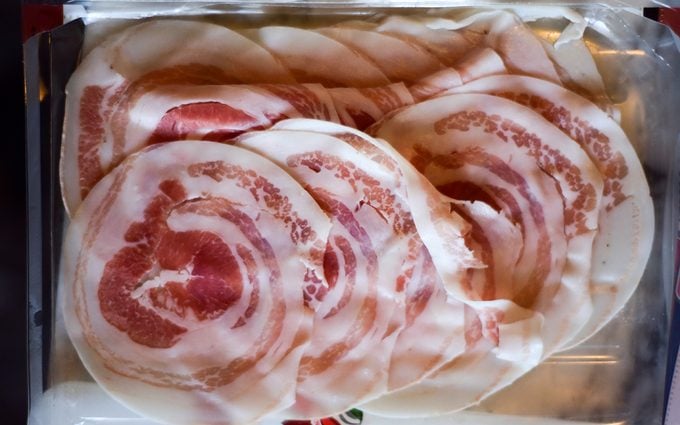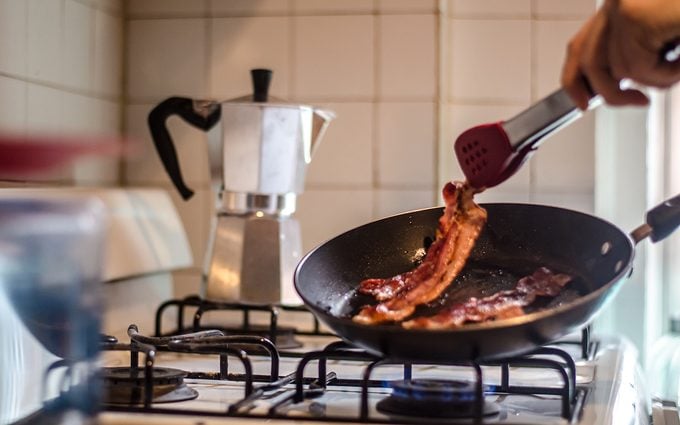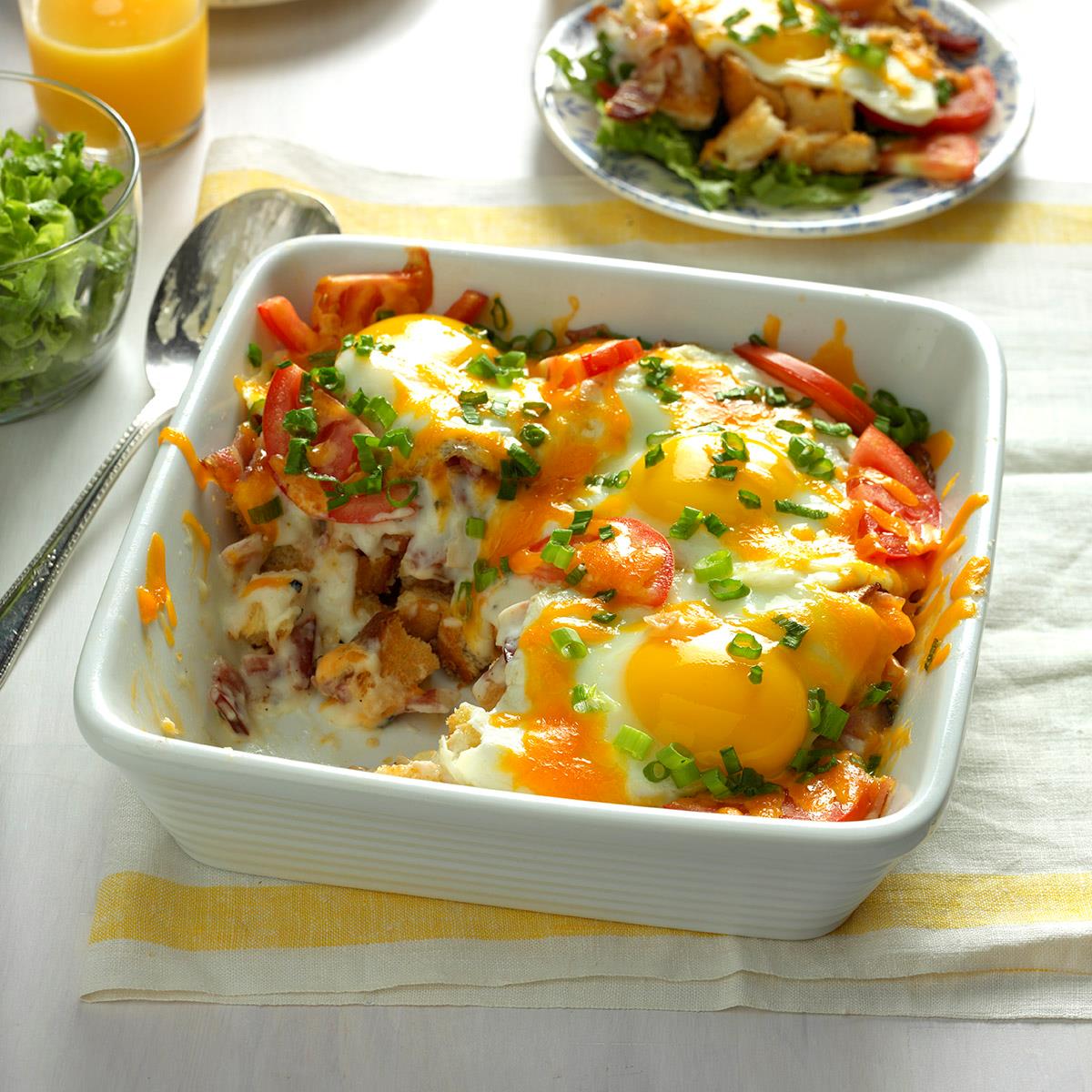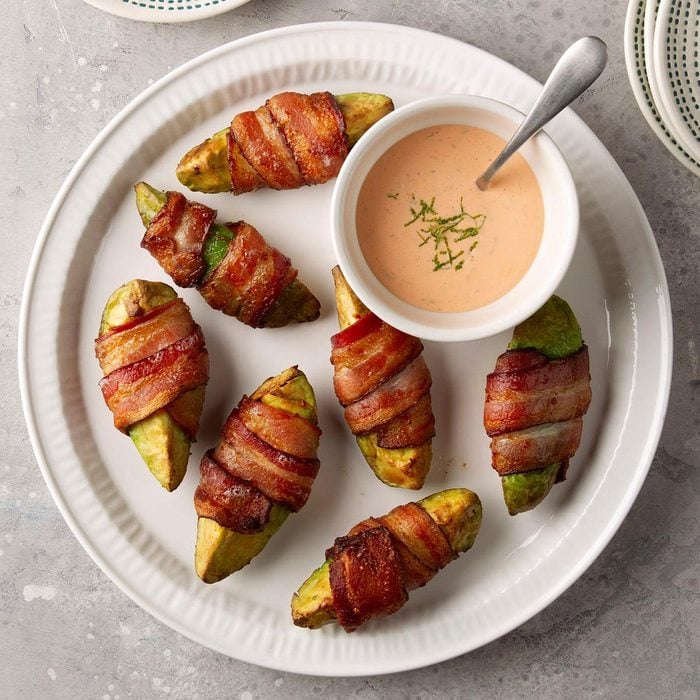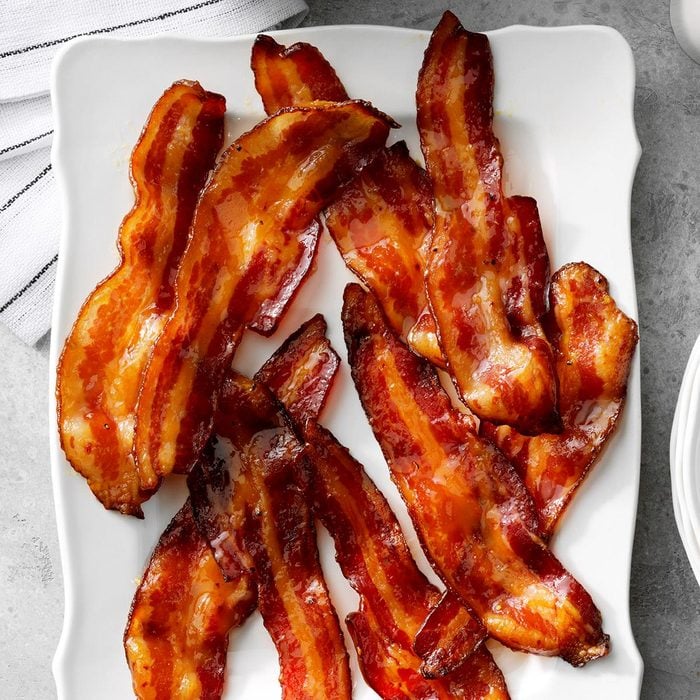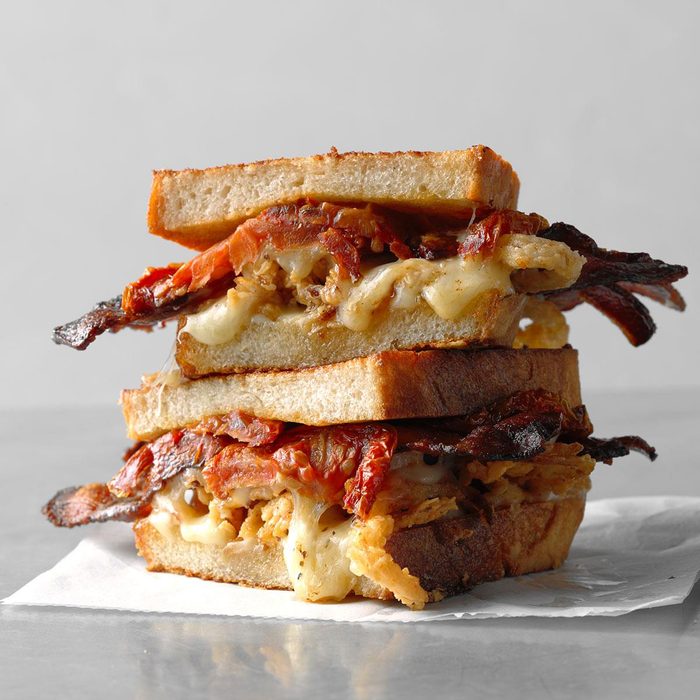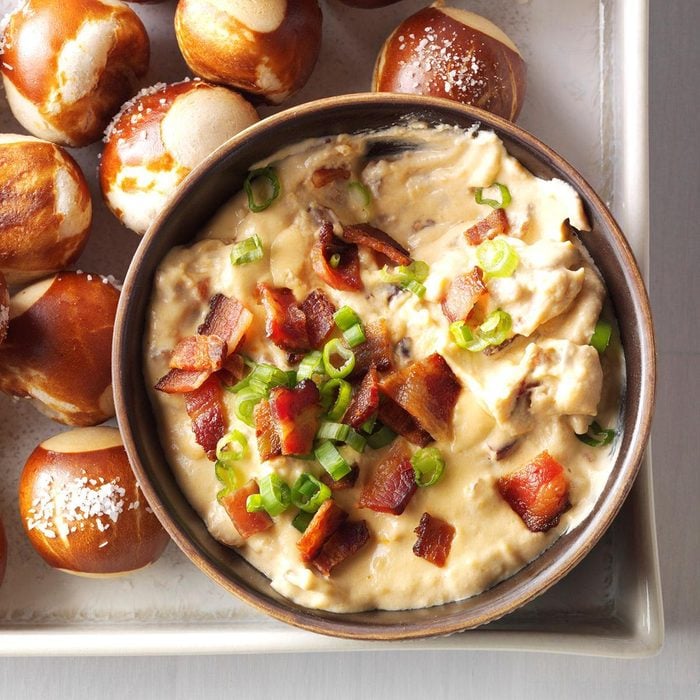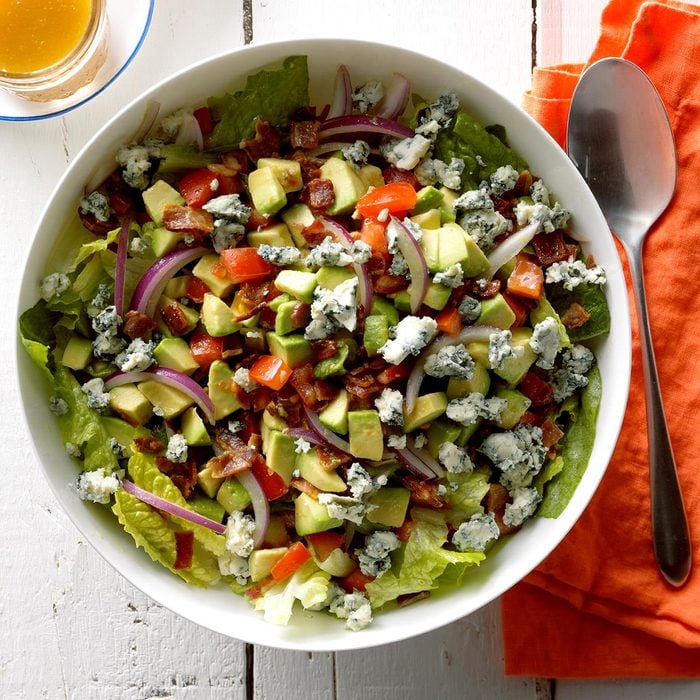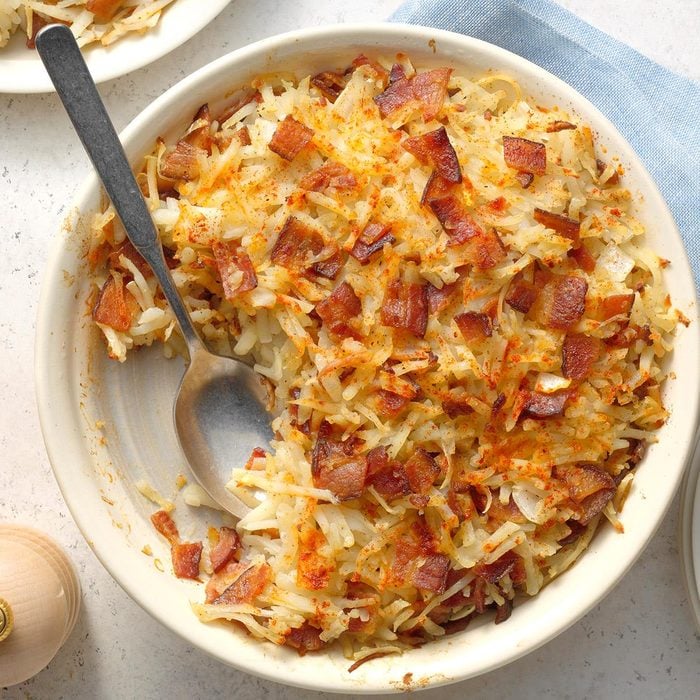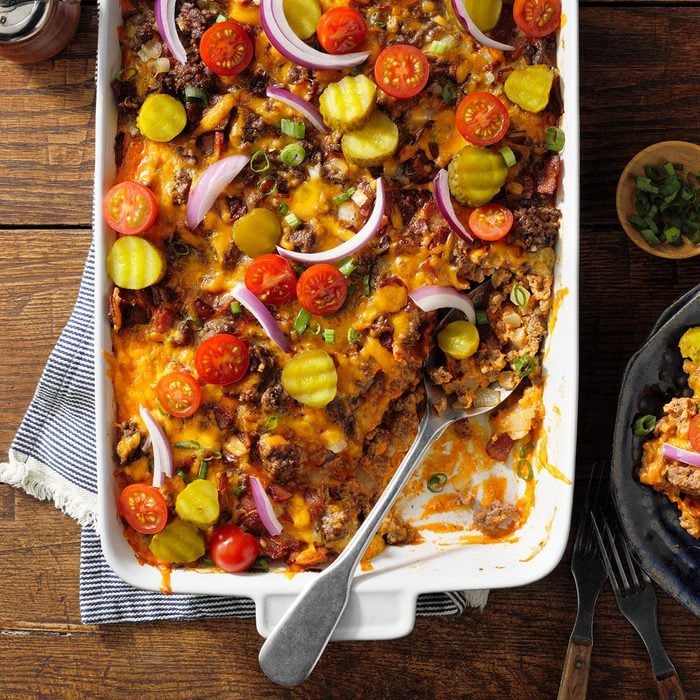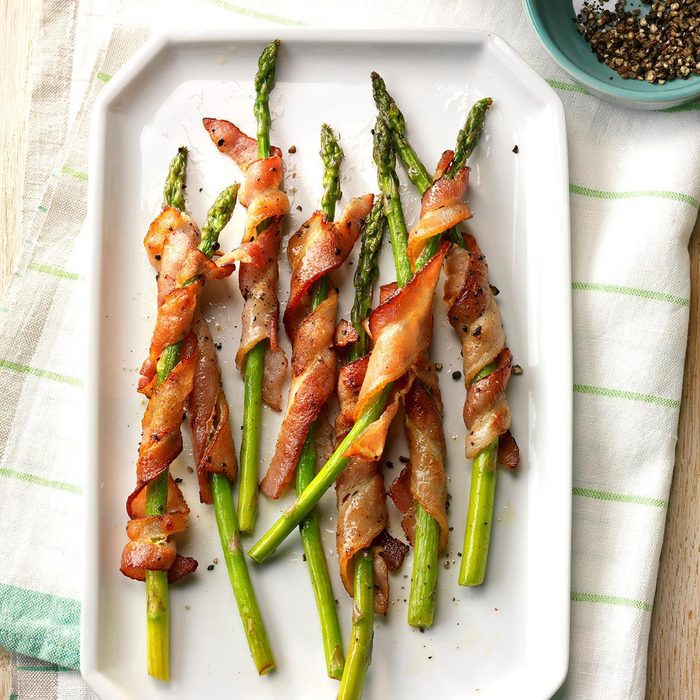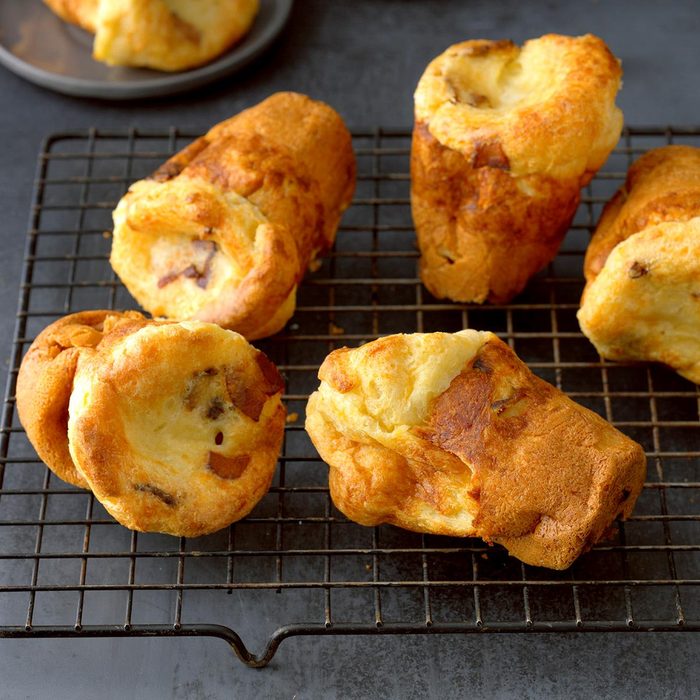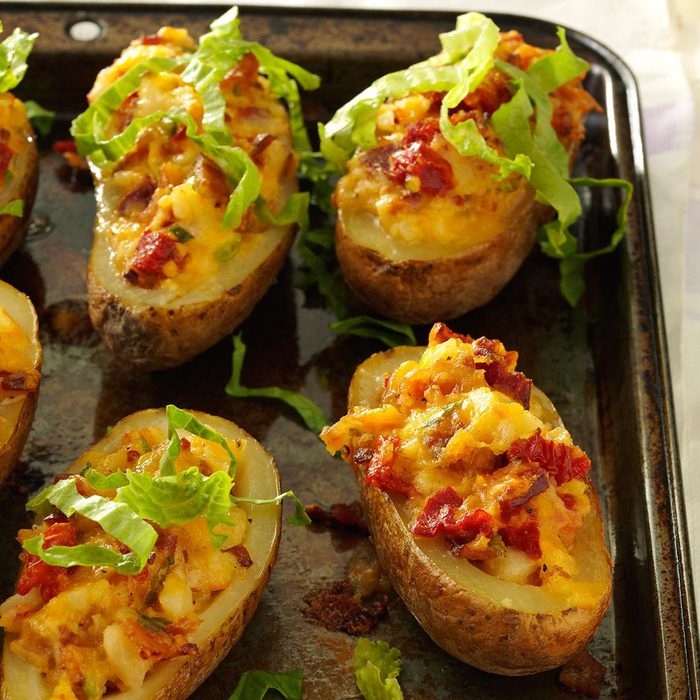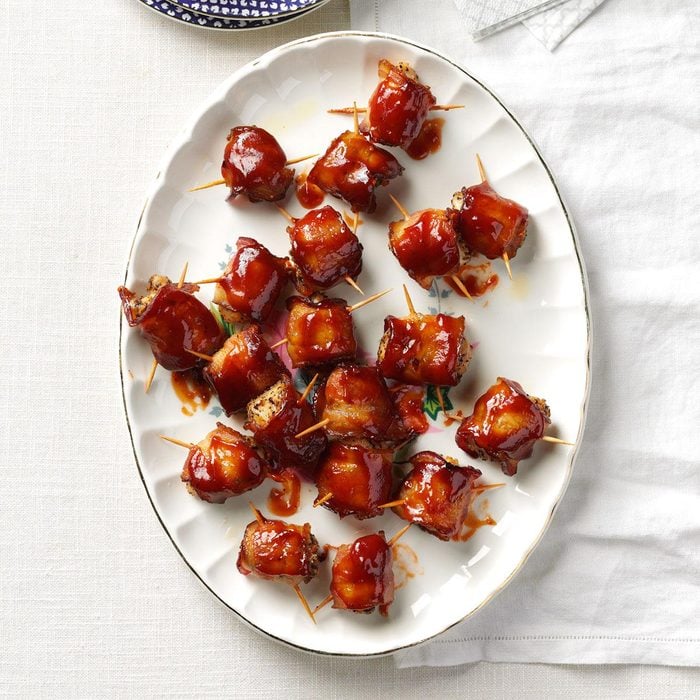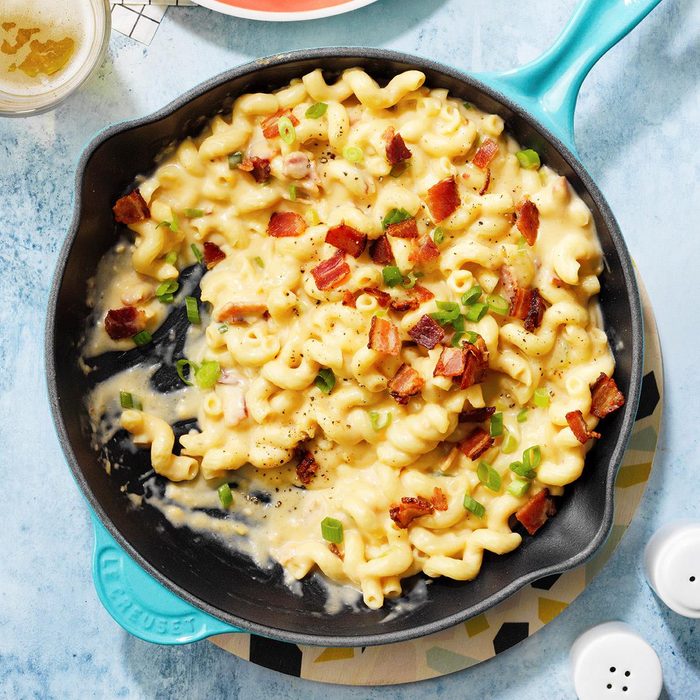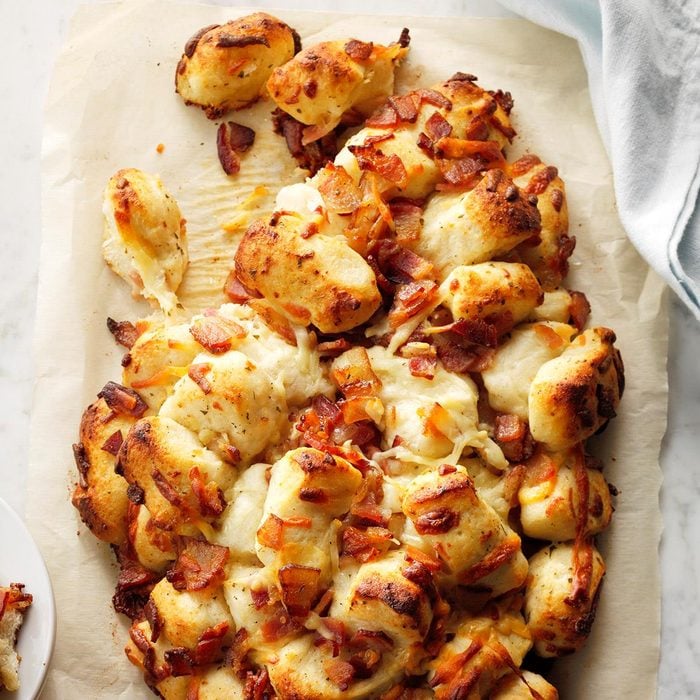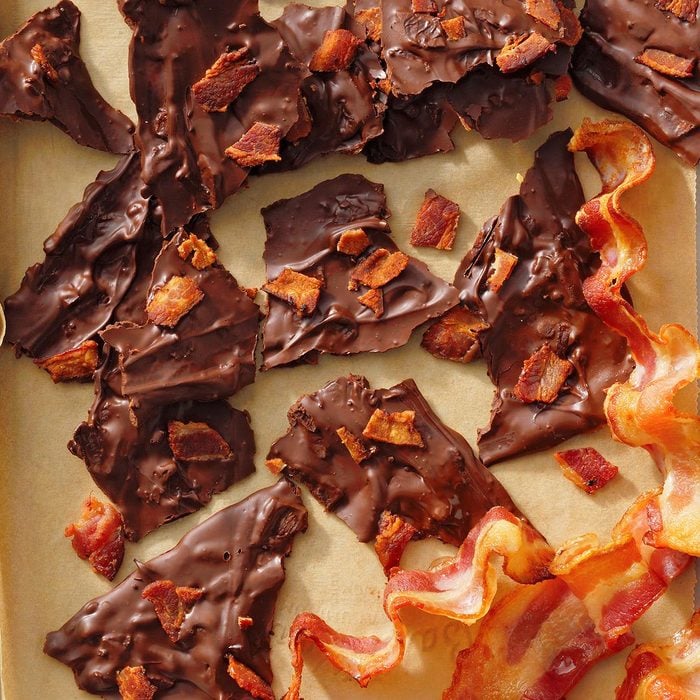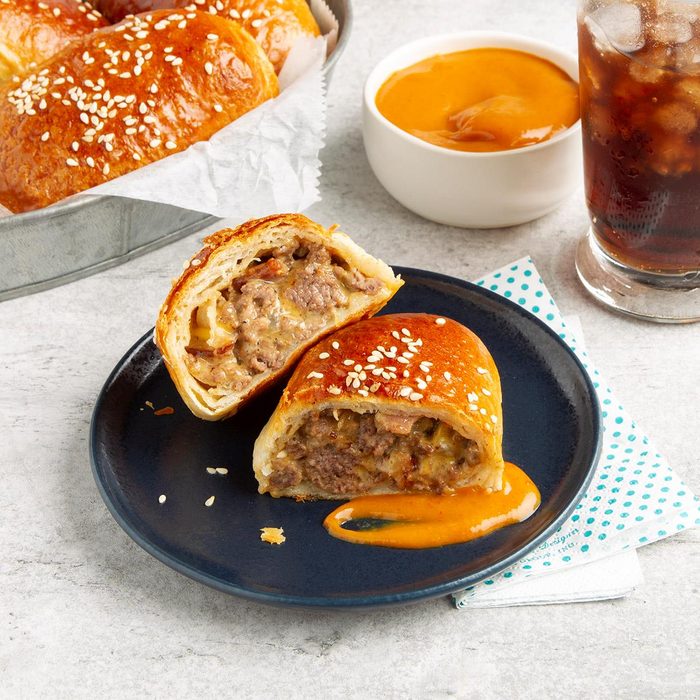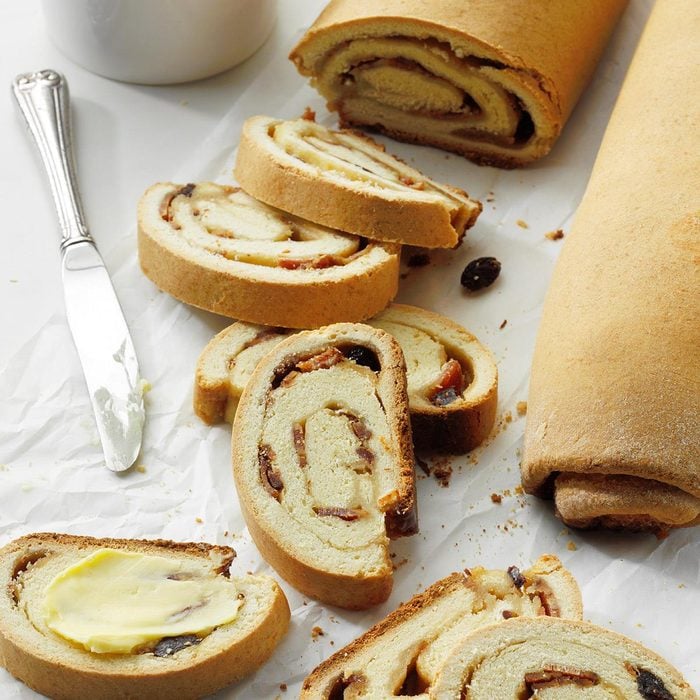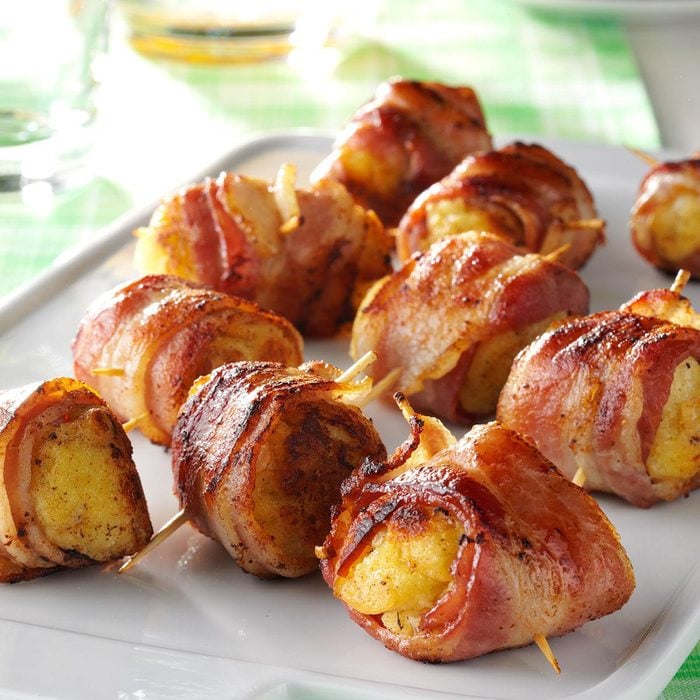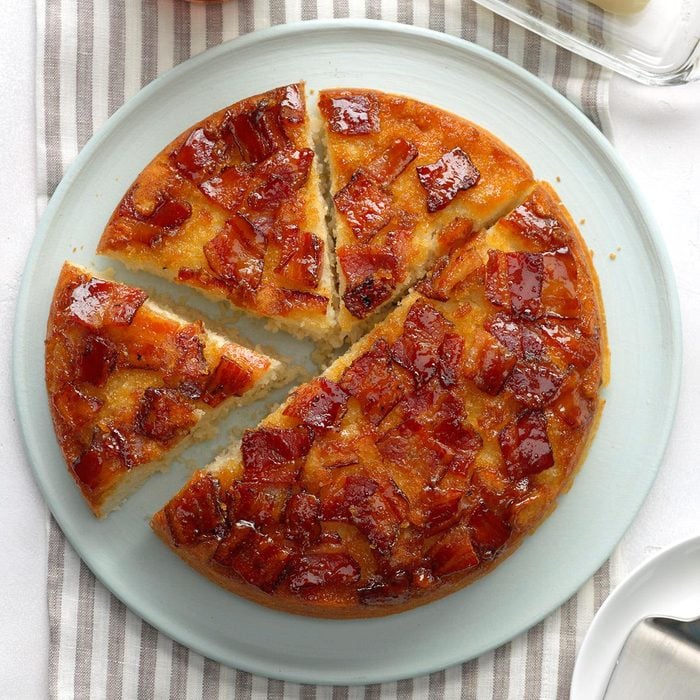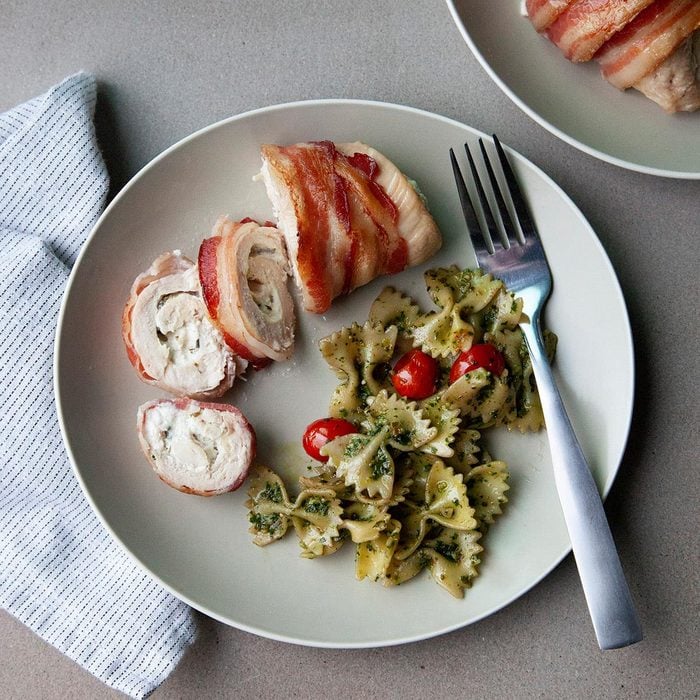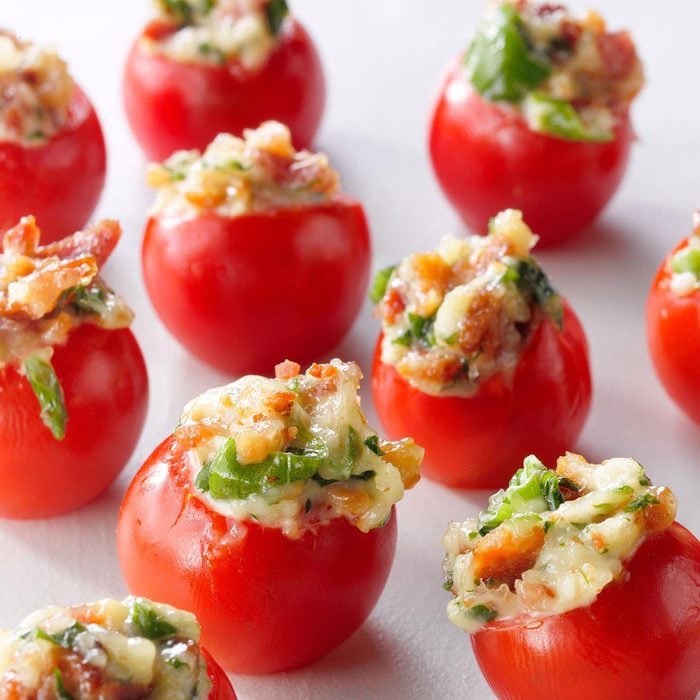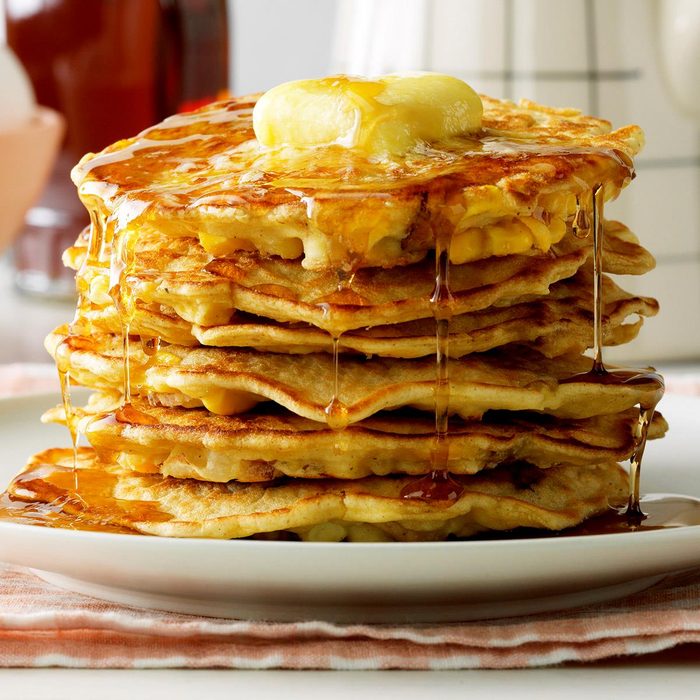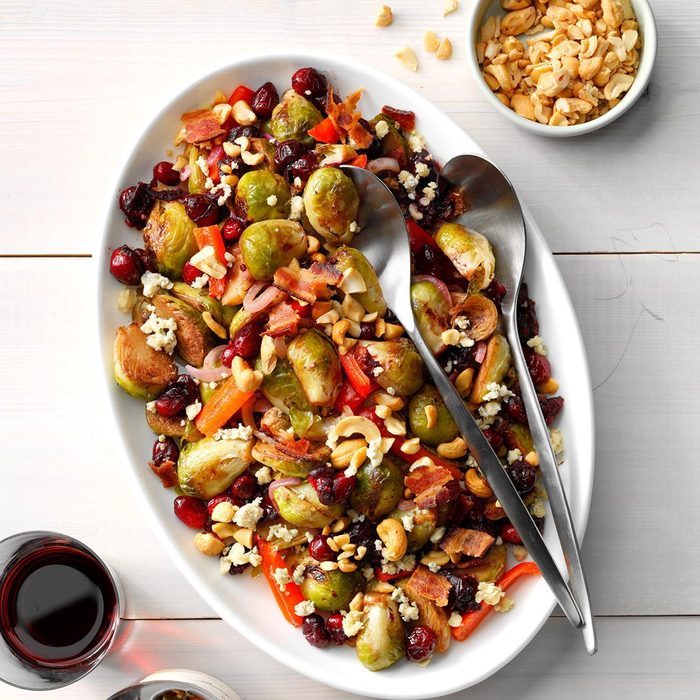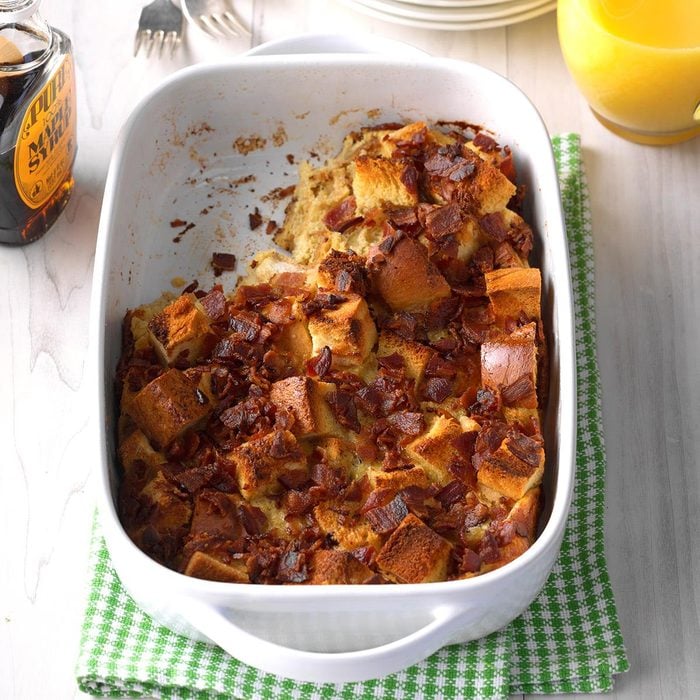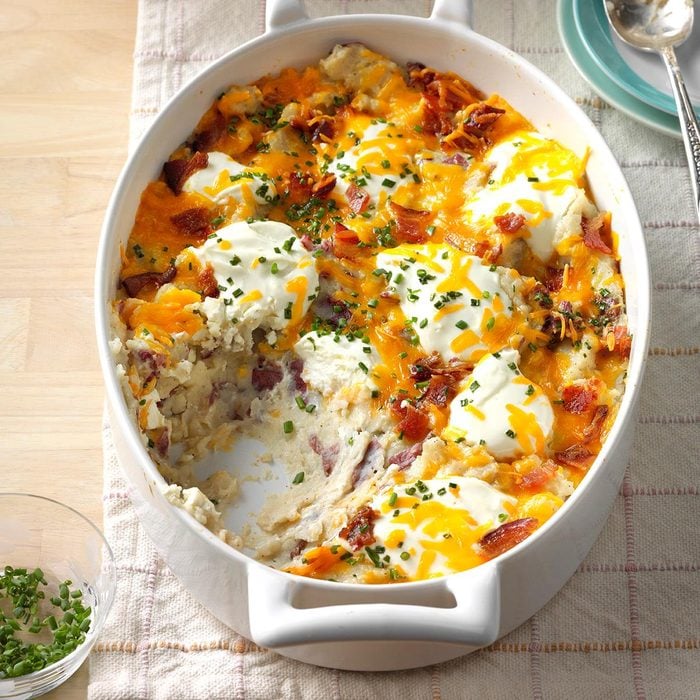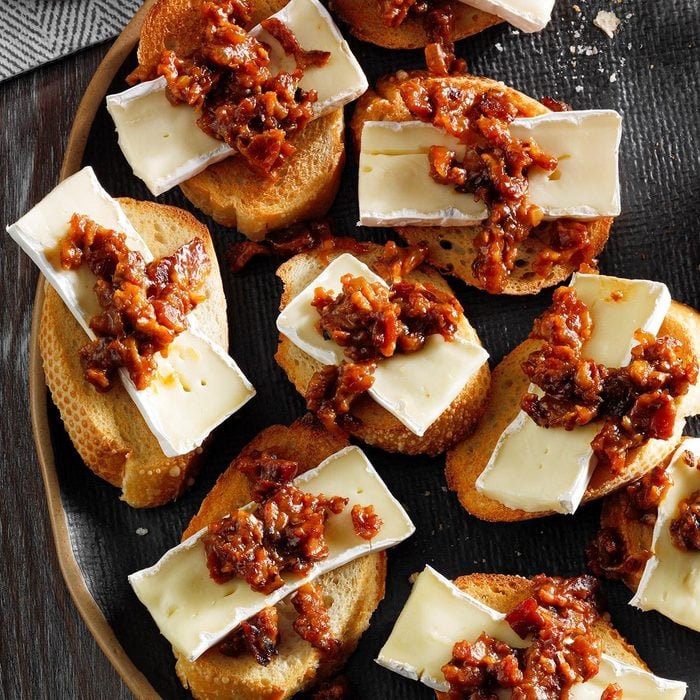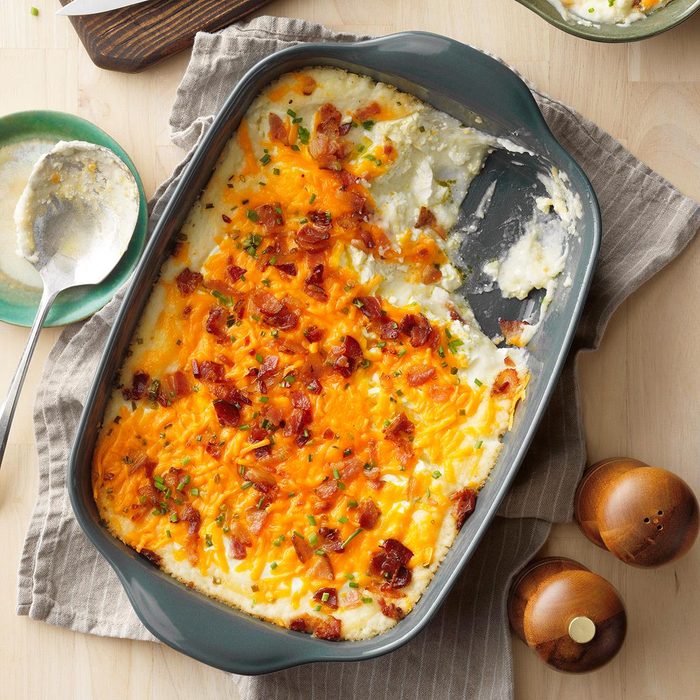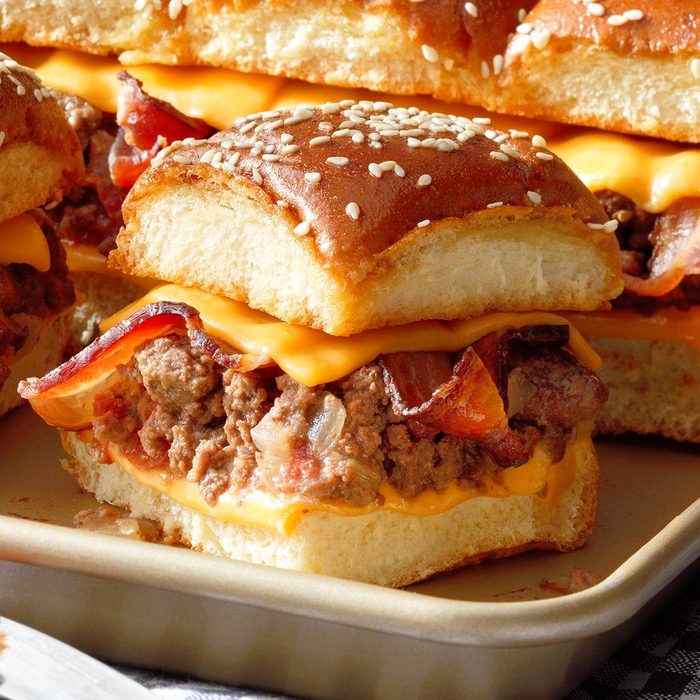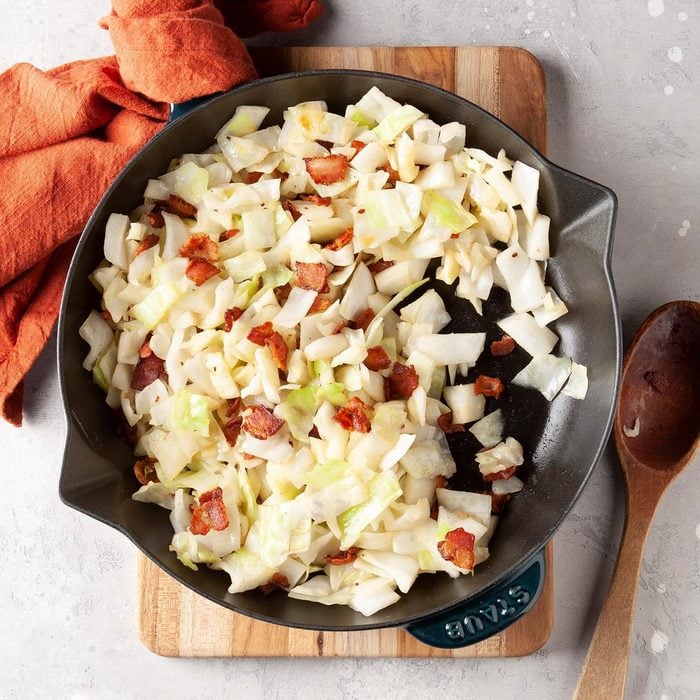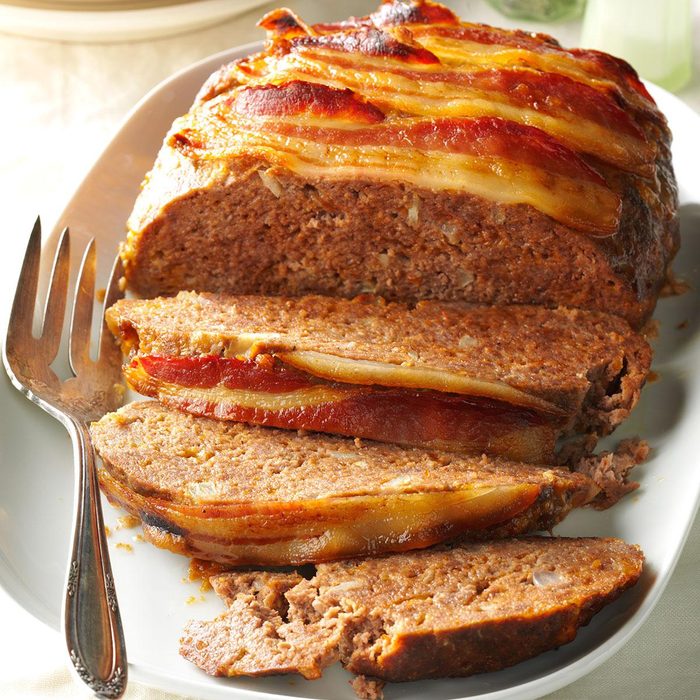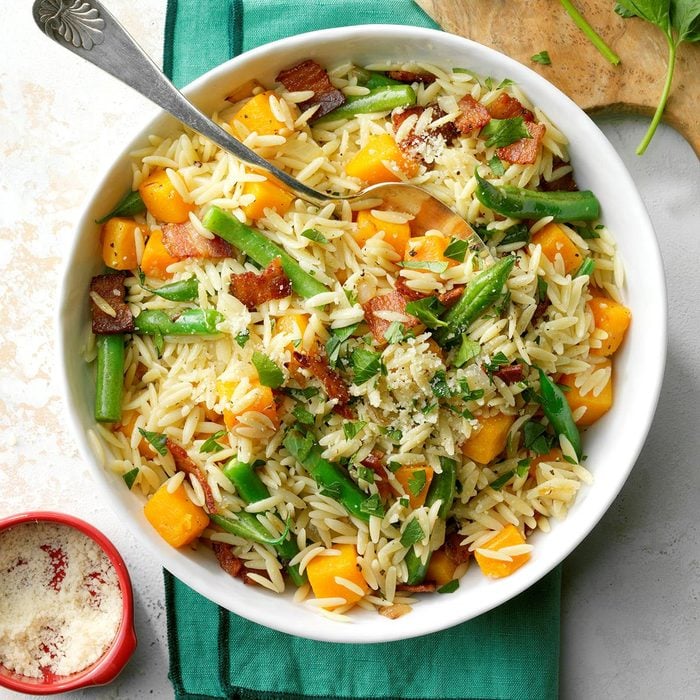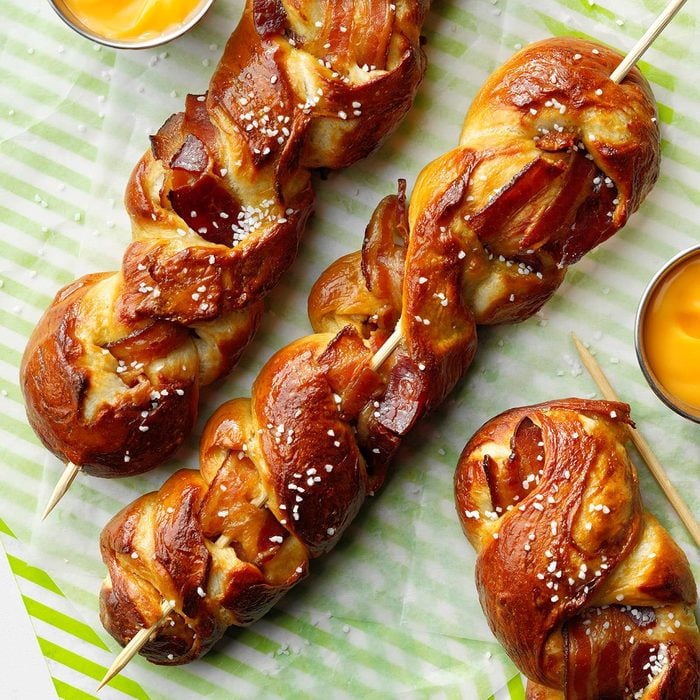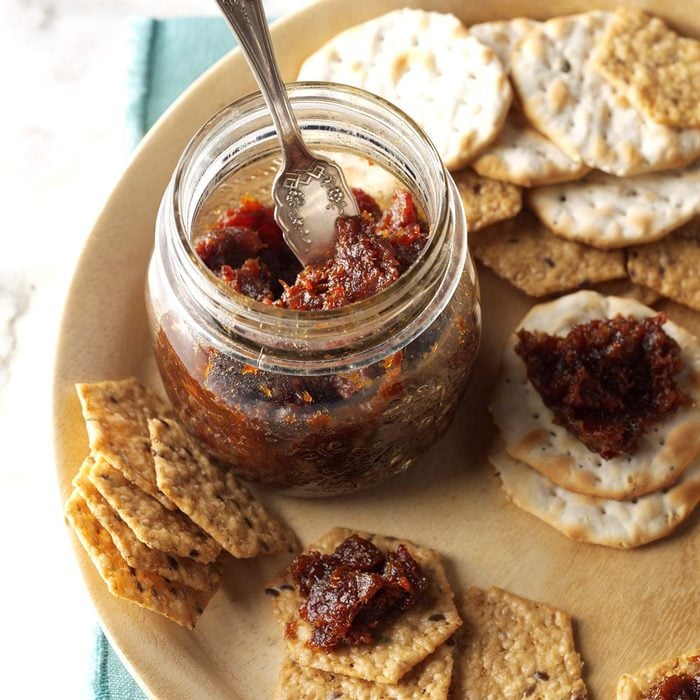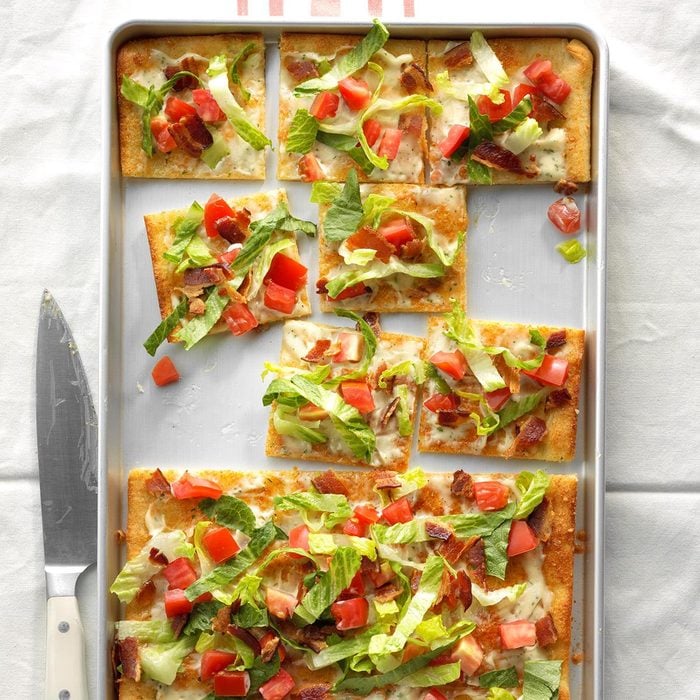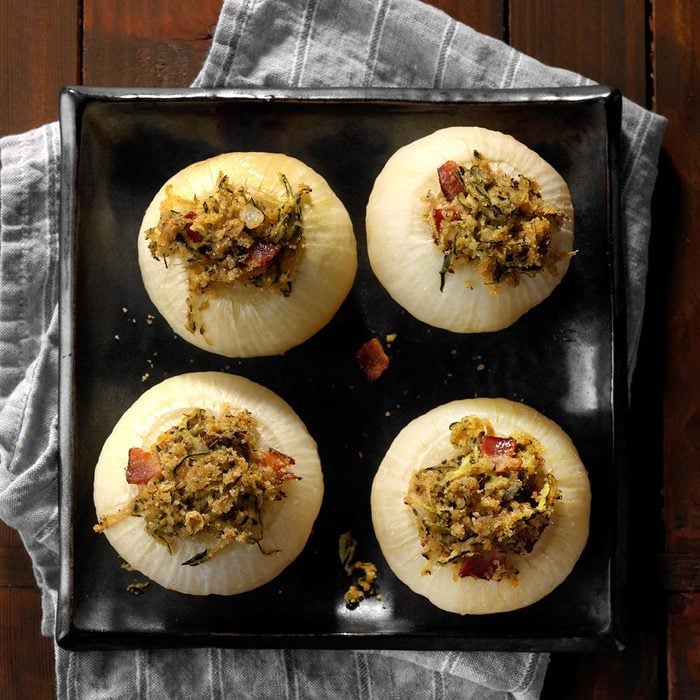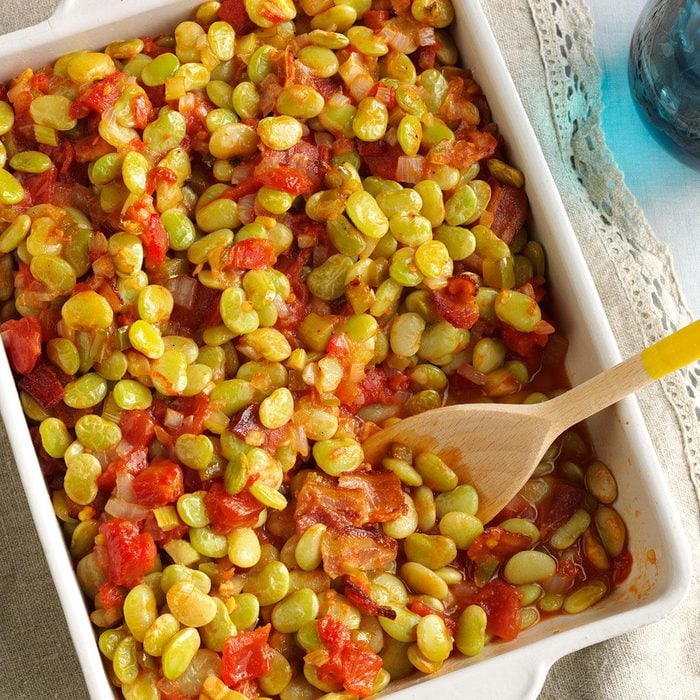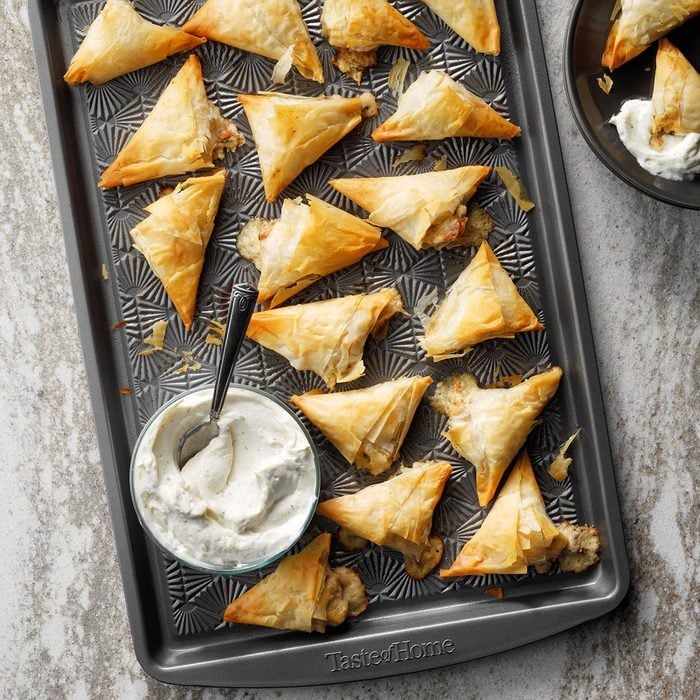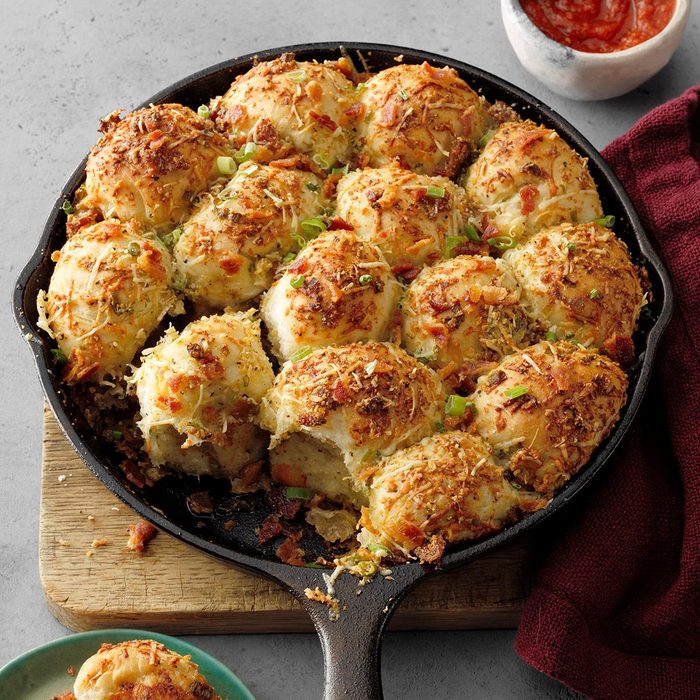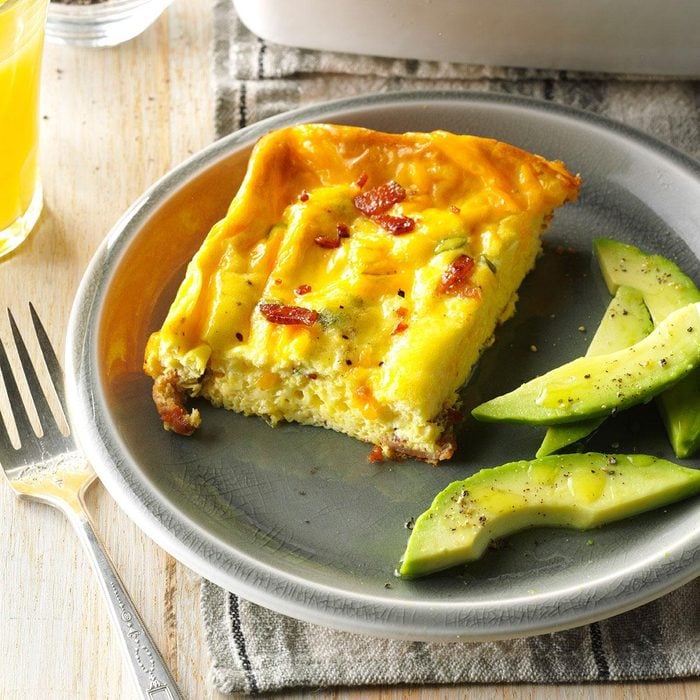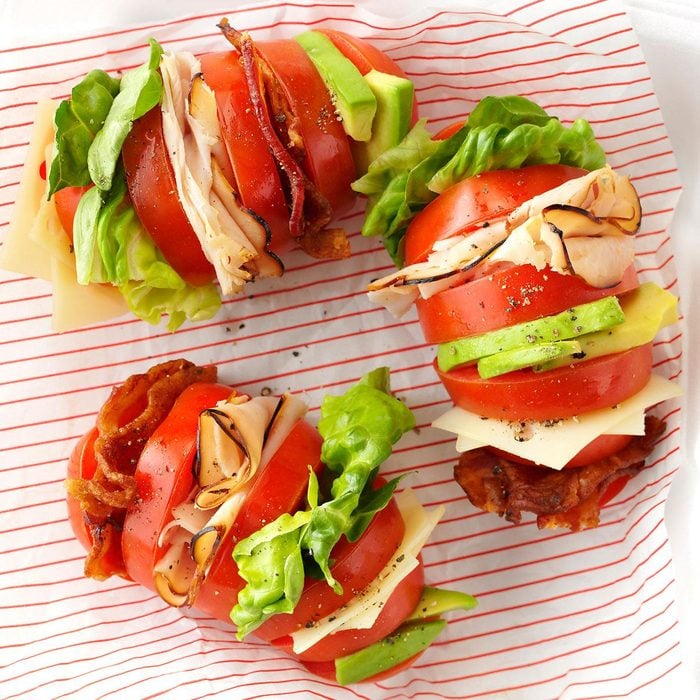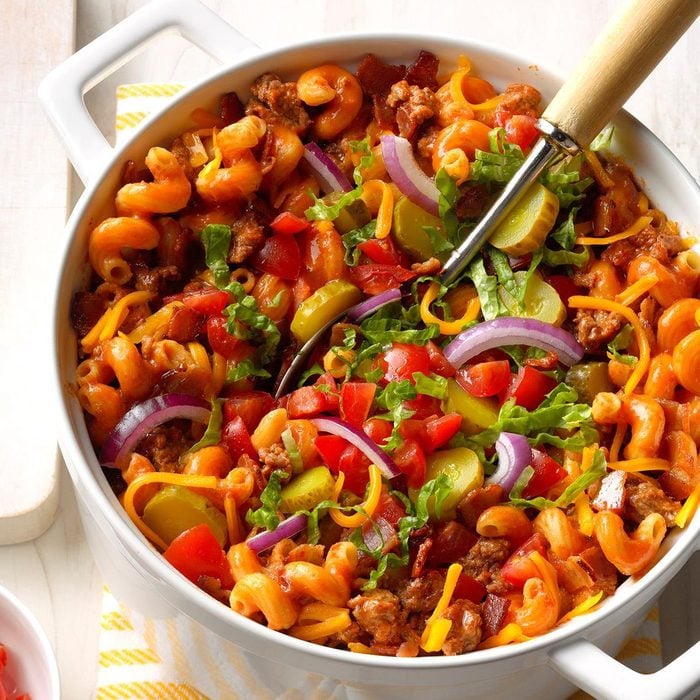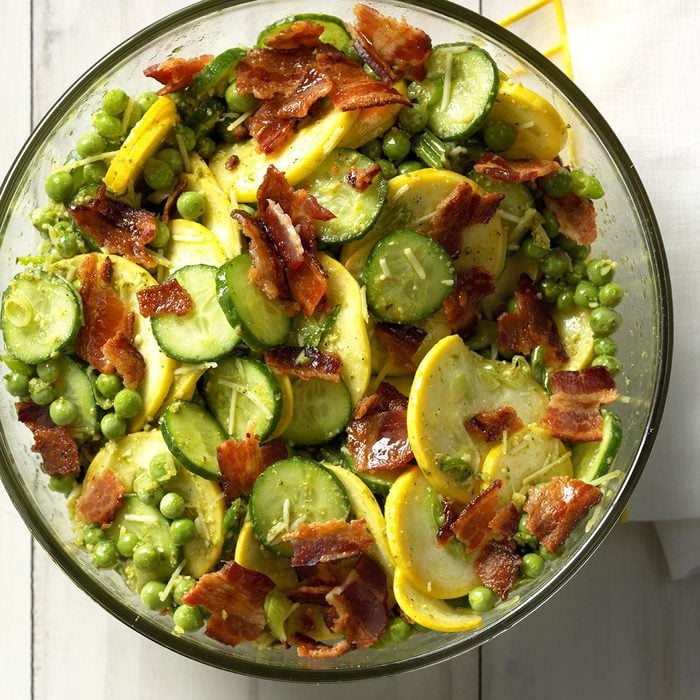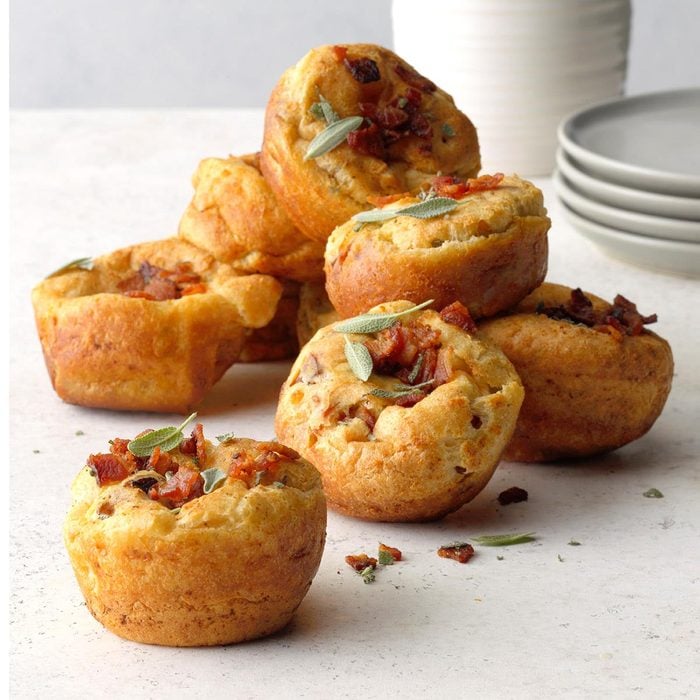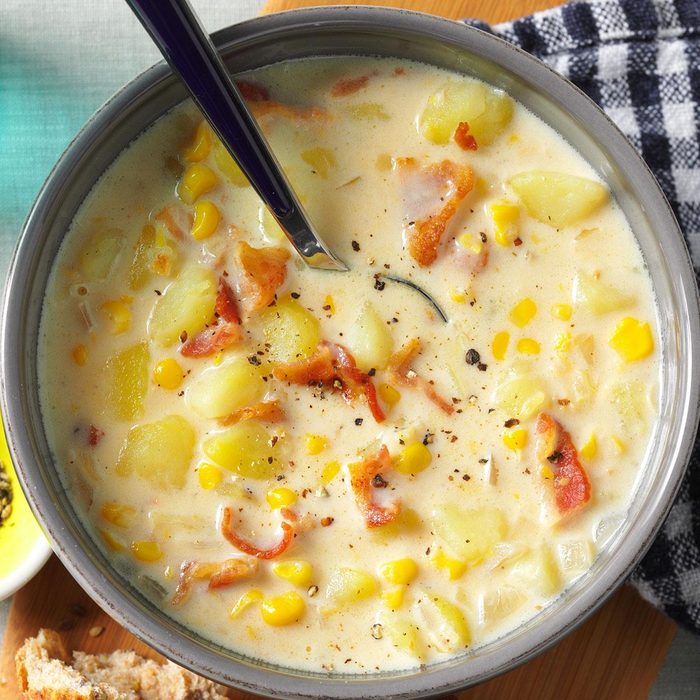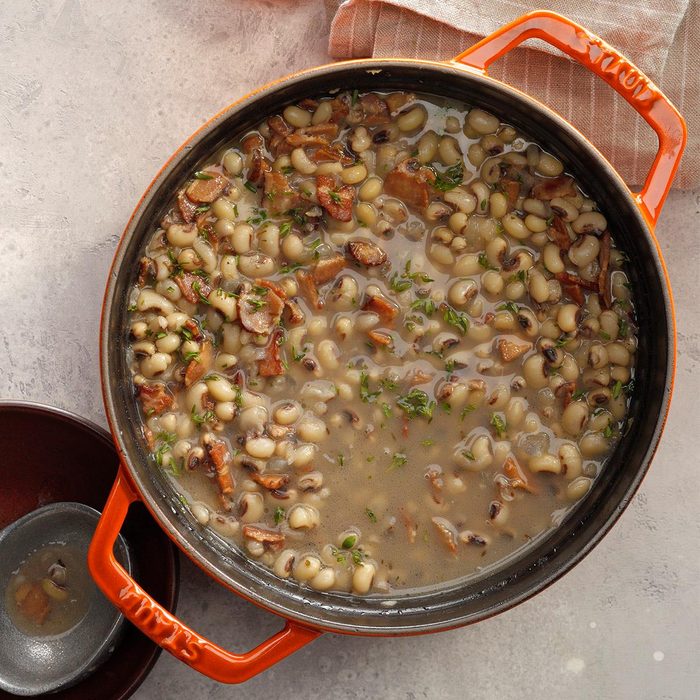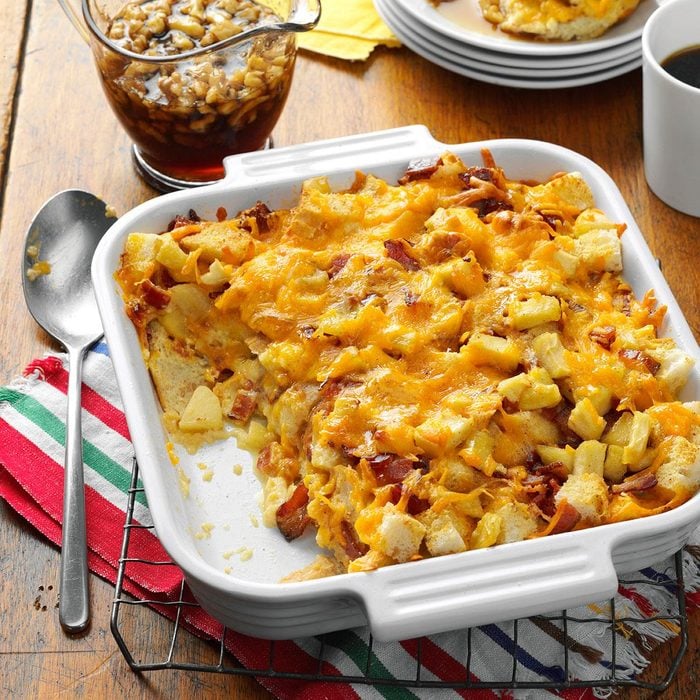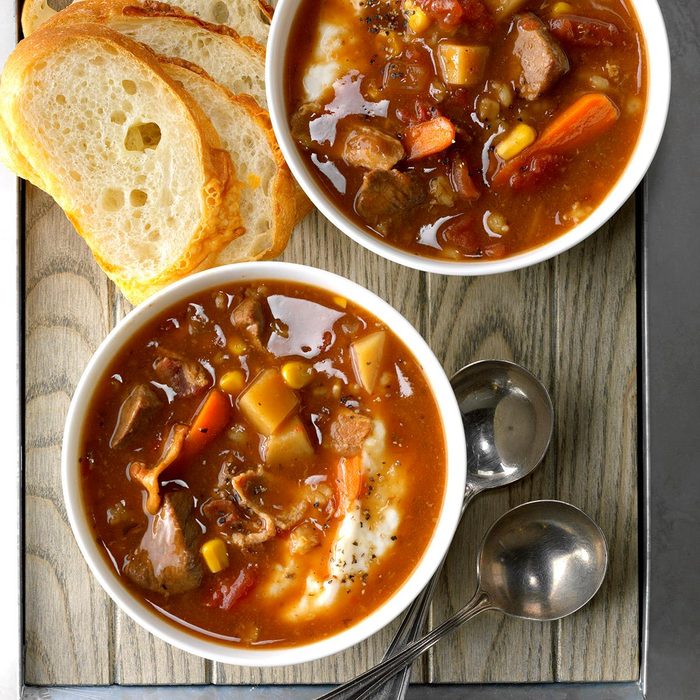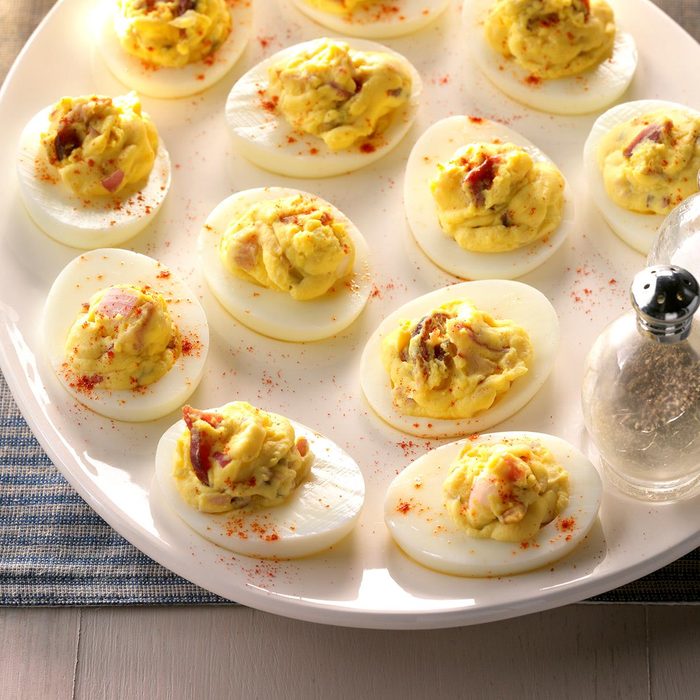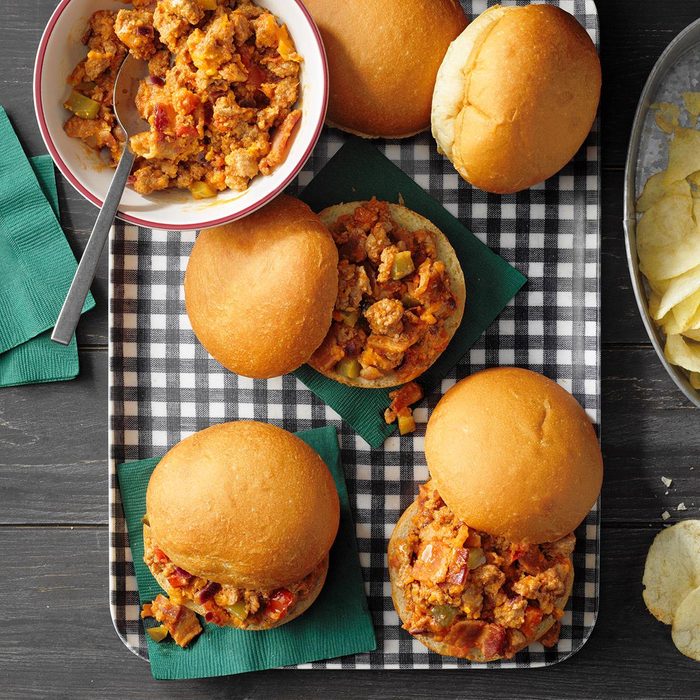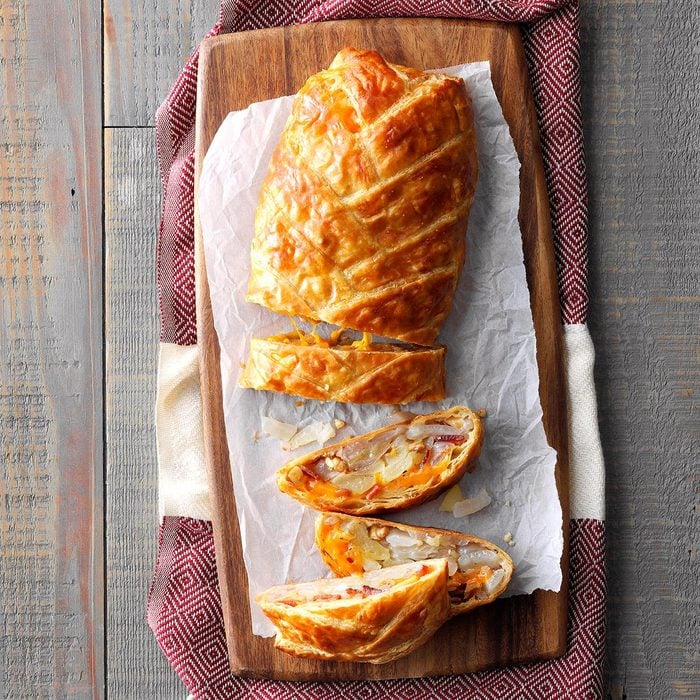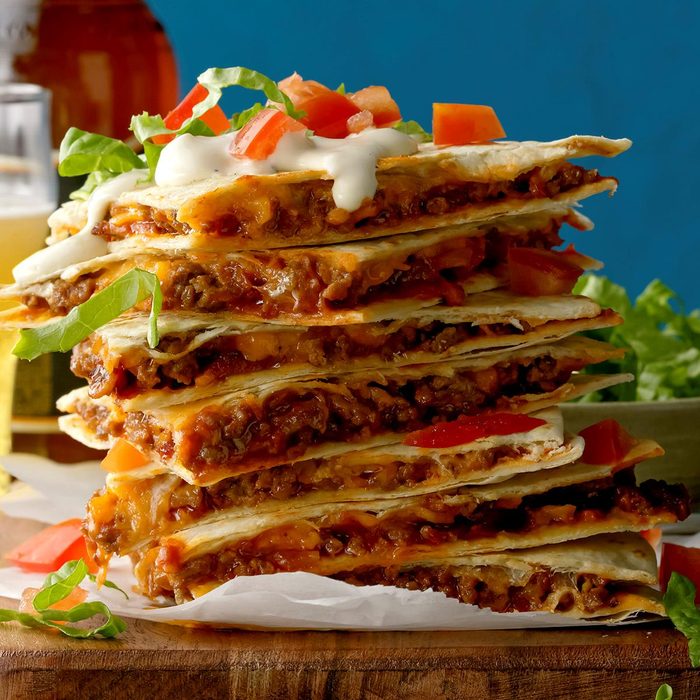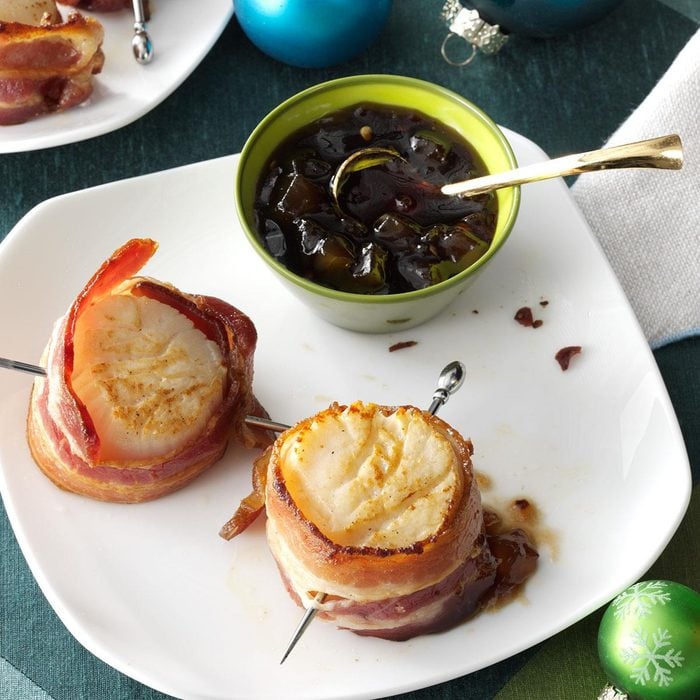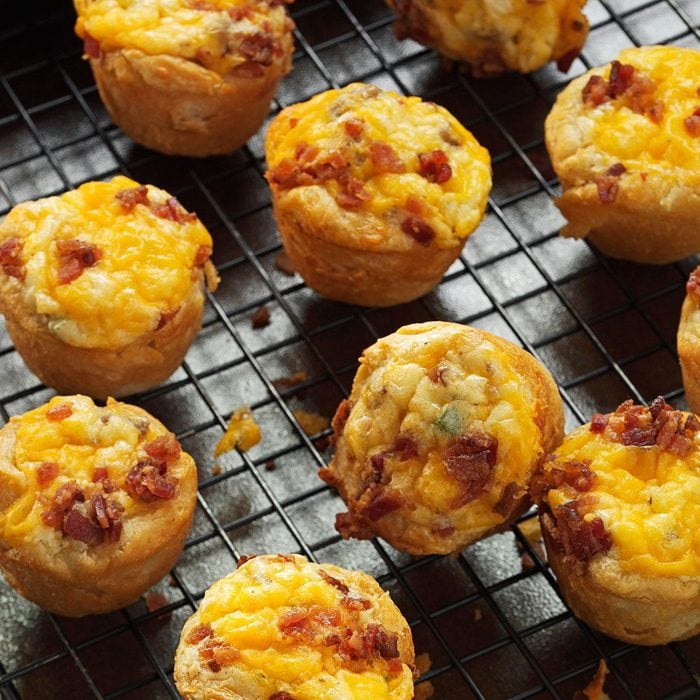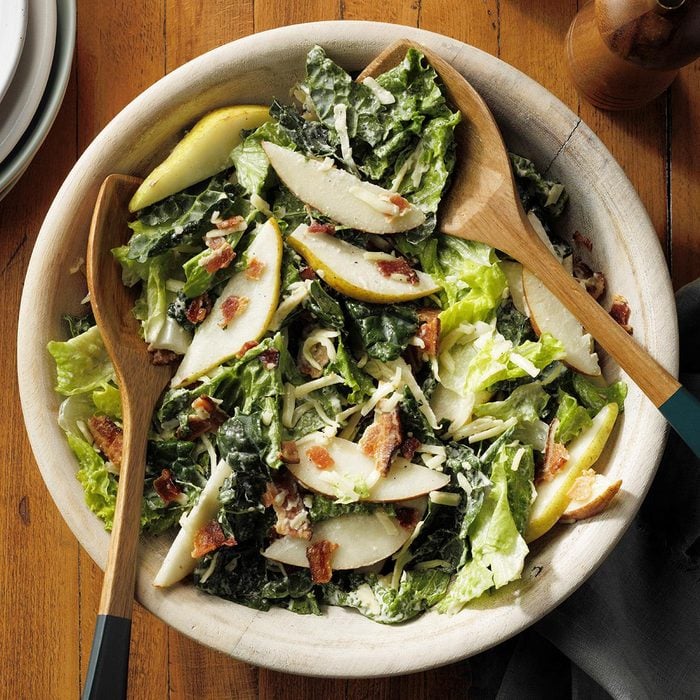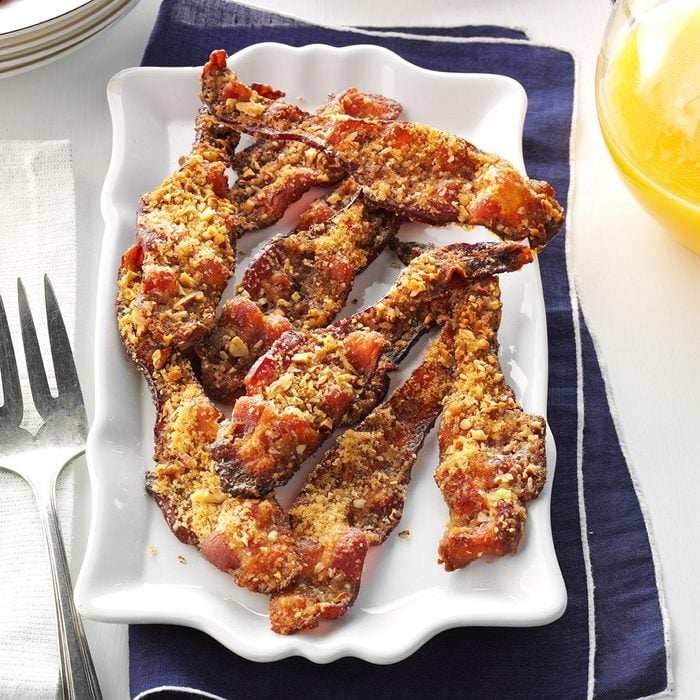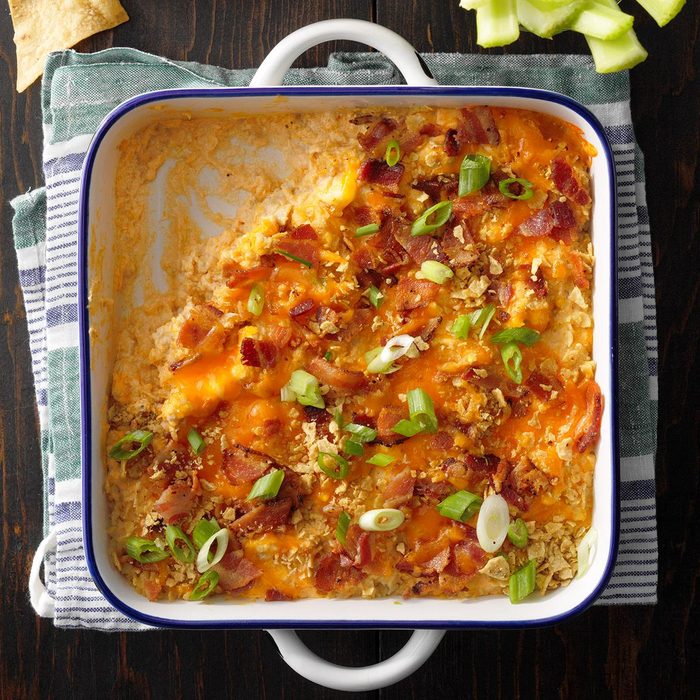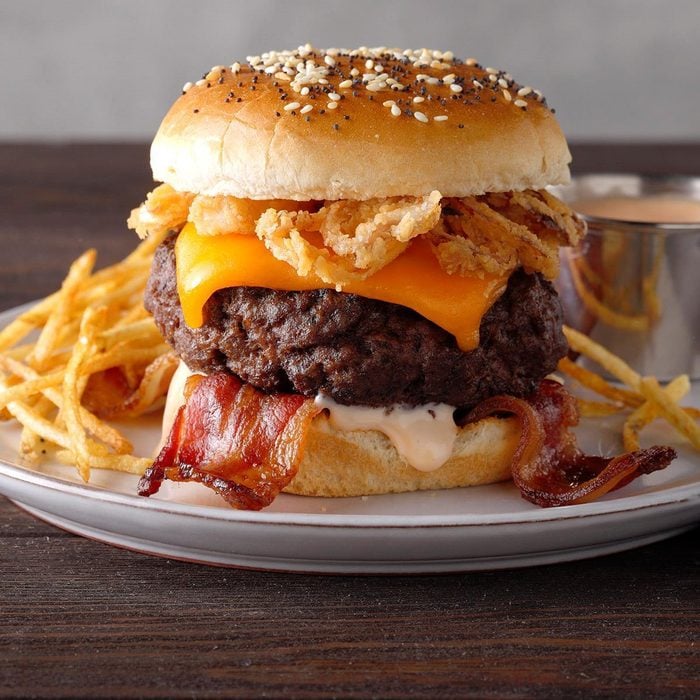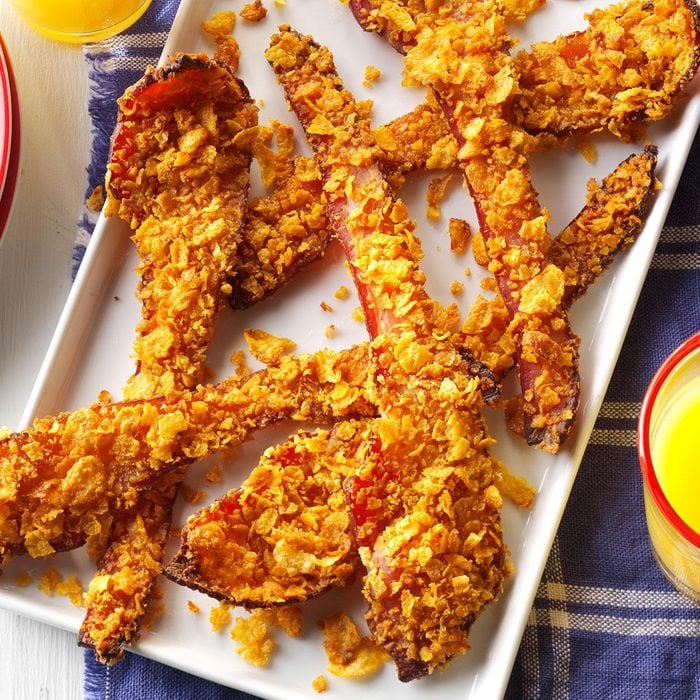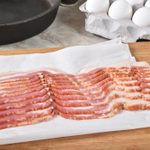BLT Egg Bake
Yes, you can have a
BLT for breakfast! This breakfast casserole makes it possible. Be sure to load it up with plenty of
good bacon and fresh red tomatoes.
Go to Recipe
Be sure to check out this farmhouse-style
bacon grease container that has nearly 12,000 five-star ratings on Amazon.
Bacon-Wrapped Avocado WedgesWe all know almost everything is improved with bacon—and avocado is no exception. Since it's made in an air fryer, this appetizer is one to remember. It will definitely impress your friends! —James Schend,
Taste of Home Deputy Editor
Orange-Glazed BaconJust when you thought bacon couldn't get any tastier, our Test Kitchen staff whipped up this tasty recipe starring the favorite breakfast meat drizzled with a sweet orange glaze. —Taste of Home Test Kitchen, Greendale, Wisconsin
Grilled Cheese, Bacon and Oven-Dried Tomato SandwichTake your grilled cheese sandwich to a place it's never been before with crispy bacon and tangy tomatoes and five—yes, five!—types of cheese. —Josh Rink,
Taste of Home Food Stylist
Pressure-Cooker Cheddar Bacon Ale DipMy tangy, smoky dip won the top prize at our office party recipe contest. Use whatever beer you like, but steer clear of dark varieties. —Ashley Lecker, Green Bay, Wisconsin
Bacon Avocado SaladEveryone in my family loves this bacon and avocado salad—even the younger kids! I serve it at pretty much every get-together I've hosted, and at this point, the recipe's been shared too many times to count. —Noreen McCormick Danek, Cromwell, Connecticut
Bacon Hash Brown BakeThis tasty side dish has wonderful from-scratch flavor since it starts with fresh potatoes. It's very popular with guests at my bed-and-breakfast.—Mark Clark, Twin Mountain, New Hampshire
BLT MuffinsThese muffins prove that the classic combo of bacon, lettuce and tomato is good for so much more than a sandwich. They're winners at both breakfast and dinner. —Katie Koziolek, Hartland, Minnesota
Bacon Cheeseburger CasseroleThis casserole has it all: ground beef, bacon, onions and cheese, all baked up in your trusty 9x13 pan. —Taste of Home Test Kitchen
Bacon Parmesan PopoversThis recipe proves that simple ingredients often result in the best-tasting dishes. These popovers are a nice change from ordinary toast or muffins. —Donna Gaston, Coplay, Pennsylvania
Bacon Collard GreensCollard greens are a staple vegetable of southern cuisine. This side dish is often eaten alongside smoked or salt-cured meats, such as ham hocks, pork or fatback. —Marsha Ankeney, Niceville, Florida
BLT Twice-Baked PotatoesTwo favorites go together in this hearty dish: BLTs and twice-baked potatoes. I like to serve these potatoes with grilled steaks or barbecued chicken. —Mary Shenk, DeKalb, Illinois
BBQ Chicken BitesChicken bites wrapped in bacon get a kick from Montreal seasoning and sweetness from barbecue sauce. We love the mix of textures. —Kathryn Dampier, Quail Valley, California
Beer and Bacon Macaroni and CheeseWe put a creative spin on classic mac and cheese by adding our favorite beer and bacon. Six tests later, we are happy. —Cindy Worth, Lapwai, Idaho
Pull-Apart Bacon BreadI stumbled across this recipe while looking for something different to take to a brunch. Boy, am I glad I did! Everyone asked for the recipe and was surprised it called for only five ingredients. It's the perfect treat to bake for an informal get-together. —Traci Collins, Cheyenne, Wyoming
Bacon Cream Cheese PinwheelsIt's hard to resist a crescent roll, bacon and cream cheese in one bite! Kids, friends,
everyone will scarf these cream cheese pinwheels down. Now I bake a double batch whenever we have a get-together. —Krista Munson, Sharpsburg, Kentucky
Chocolate Bacon BarkSweet, salty, crunchy, smooth—bacon and chocolate is a match made in heaven in this chocolate bacon bark. —James Schend,
Taste of Home Deputy Culinary Editor
Bacon Cheeseburger RollsMy husband and I both love these cheeseburger rolls. I often serve them with broccoli and cheese. They must be good because this recipe won the first-place prize at the Iowa State Fair! —Jessica Cain, Des Moines, Iowa
Bacon Quiche TartsFlavored with vegetables, cheese and bacon, these memorable morsels are bound to be winners at any brunch. The tarts are impressive but also quite easy to make. For garnish, sprinkle on some chopped green onion.
—Kendra Schertz, Nappanee, Indiana
Maple Bacon BreadSwirled with maple syrup, raisins, bacon and brown sugar, this crave-worthy maple bacon bread is one they'll remember. Plus, the dough is easy to work with and roll out! —Alicia Rooker, Milwaukee, Wisconsin
Cheddar Corn Pudding with BaconThis cheddar corn pudding can be prepared ahead and refrigerated overnight. Remove from the refrigerator for 30 minutes before baking. —Lynn Albright, Fremont, Nebraska
Bacon Roll-UpsThis family recipe dates back to the 1930s, when my grandmother started making these tasty bites. Now I’m proud to serve them to my loved ones. They’re terrific for brunch, too. —Janet Abate, North Brunswick, New Jersey
Upside-Down Bacon PancakeMake a big impression when you present one family-sized bacon pancake. The brown sugar adds sweetness that complements the salty bacon. If you can fit more bacon in the skillet and want to add more, go for it. —Mindie Hilton, Susanville, California
Bacon-Wrapped ChickenTender chicken gets a special treatment when spread with a creamy filling and wrapped with tasty bacon strips. This easy
bacon-wrapped chicken recipe is frequently requested by my bunch. —MarlaKaye Skinner, Tucson, Arizona
Dutch Oven Cheesy Bacon & EggsFor campouts, my sister and I escape on horseback into the woods. We make this Dutch oven breakfast casserole the first morning, then love the leftovers for the rest of the trip. —Mary Burris, Okeechobee, Florida
BLT BitesThese quick
hors d'oeuvres may be mini, but their bacon and tomato flavor is full size. I serve them at parties, brunches and picnics, and they're always a hit...even my kids love them. —Kellie Remmen, Detroit Lakes, Minnesota
Bacon Corn PancakesPancakes are always tops in my book. But stir in bacon and corn, and they become the best breakfast-for-dinner option. I always cook gluten-free, but you can easily use regular all-purpose flour to make these corn fritters. —Anne-Marie Nichols, Watkinsville, Georgia
Crunchy Bacon Blue Cheese Red Pepper Brussels SproutsThis is my family's absolute favorite dish on my holiday table. What's not to love with the mixed aroma of garlic, onions, bacon, and blue cheese floating through your home? —Jana Gooding, Carlsbad, California
Sheet-Pan Eggs and Bacon BreakfastI saw this sheet-pan eggs and bacon recipe on social media and decided to re-create it. It was a huge hit! Use any cheeses and spices you like—you can even try seasoned potatoes. —Bonnie Hawkins, Elkhorn, Wisconsin
Maple Bacon French Toast BakeOur family loves Sunday brunch. Each season I try to bring a little different flavor to the table. This French toast bake reminds us of fall. Whole or 2% milk works best, but I use regular almond milk because I can't have dairy and it works, too! —Peggie Brott, Milford, Kansas
Loaded Red Potato CasseroleThis potato casserole has the same flavor of the potato skins you can order as a restaurant appetizer. It's an ideal dish for tailgating and potlucks. —Charlane Gathy, Lexington, Kentucky
Brie Appetizers with Bacon-Plum JamAmong my friends I'm known as the pork master, because I love to cook just about every cut there is. These appetizers combine soft, mild Brie cheese with a sweet-sour bacon jam that has a touch of Sriracha sauce. —Rick Pascocello, New York, New York
Maple Bacon Walnut Coffee CakeWake up the sleepyheads in your household with this moist, tender coffee cake that’s both sweet and savory. Bacon and nuts in the crumbly topping blend with flavors of maple, nutmeg and cinnamon. Yum! —Angela Spengler, Clovis, New Mexico
“Everything” Mashed Potato CasseroleThe everything-mashed potato casserole seemed to evolve over a year and it’s a great dish to take to a covered dish event. If I need to keep it warm for a longer time, I sometimes place the mixture into a Crockpot and then add the sour cream, bacon, cheese and chives. —Pamela Shank, Parkersburg, West Virginia
Bacon Cheeseburger Slider BakeI created this dish to fill two pans because these sliders disappear fast. Cut the recipe in half if you want one batch. —Nick Iverson, Milwaukee, Wisconsin
Bacon Cabbage Stir-FryFor a flavorful side dish, try this fried cabbage and bacon. It's not only delicious, but fast to fix when you need to get dinner on the table quickly. —Lori Thompson, New London, Texas
Bacon-Topped Meat LoafMy family loves meat loaf—and this one in particular. I created this bacon meatloaf after trying and adjusting many other recipes over the years. Cheddar cheese tucked inside and a flavorful bacon topping dress it up just right for Sunday dinner! —Sue Call, Beech Grove, Indiana
Looking for more variations? Try our favorite
bacon-wrapped meatloaf.
Dijon-Bacon Dip for PretzelsWith just four ingredients that you probably already have in your pantry or fridge, this quick appetizer comes together in a snap. If you like the zip of horseradish, start with a teaspoon or two and add more to taste. —Isabelle Rooney, Summerville, South Carolina
Orzo with Caramelized Butternut Squash and BaconWhen my garden produced a bumper crop of butternut squash, I made multiple new dishes to use up my bounty! This is a tasty, easy side with pretty colors, and it makes plenty to fill your hungry family. To make it into a main, add shrimp or shredded chicken. —Kallee Krong-McCreery, Escondido, California
Bacon Pretzel FuryI tried a bacon pretzel fury the last time I was at Busch Gardens, and afterward I ferociously tried to re-create it at home. I don't live anywhere close to the amusement park, so this version curbs my hankerings when back in the Midwest. —Alvin Ciepluch, Kenosha, Wisconsin
Caprese Chicken with BaconSmoky bacon, fresh basil, ripe tomatoes and gooey mozzarella top this appealing chicken caprese recipe. The aroma as it bakes is irresistible! —Tammy Hayden, Quincy, Michigan
Gentleman's Whiskey Bacon JamBacon's not just for breakfast or for slipping in a BLT. Turn this salty treat into a jam and spread it on everything from crackers to burger buns! Not sure which brand of bacon to buy?
Check out the brands our editors and the Taste of Home Test Kitchen recommend.
Bacon, Lettuce and Tomato PizzaI combine two all-time favorites in this recipe: pizza and BLT sandwiches. I brought this fun mashup to a ladies lunch and was met with lots of oohs and aahs. —Bonnie Hawkins, Elkhorn, Wisconsin
Easy Glazed BaconBrown sugar, mustard and wine make bacon a little more special in this recipe. It's easy to prepare while working on the rest of the meal. —Judith Dobson, Burlington, Wisconsin
Stuffed Sweet Onions with BaconThis unexpected side dish is perfect to serve alongside grilled steak or pork chops. Even if you're not an onion fan, the low heat and long cooking time of this dish mellows and sweetens the sometimes sharp raw onion flavors that many dislike.—Erin Chilcoat, Smithtown, New York
Beans, Bacon & Tomato BakeBacon, tomatoes and lima beans combine for a nutrient-packed side dish that makes the perfect accompaniment to turkey. —Karen Kumpulainen, Forest City, North Carolina
Chicken Bacon TrianglesWe host an annual Christmas party, and I whip up a new menu item every year. These golden chicken and bacon appetizers were an absolute hit. —Annette Fecht, Sorrento, British Columbia
Bacon-Wrapped ShrimpI tweaked this bacon-wrapped shrimp recipe to please my family, and boy were they glad! For less heat, skip the jalapenos. —Debbie Cheek, State Road, North Carolina. If you enjoyed this recipe, then you must try
bacon-wrapped pork chops.
Parmesan-Bacon Bubble BreadWhen I needed to put some leftover bread dough to good use, I started with a recipe I often use for bubble bread and substituted savory ingredients for the sweet. —Lori McLain, Denton, Texas
Bacon and Eggs CasseroleBecause it's fast to fix and such a great hit with family and friends, this egg casserole with bacon is a favorite of mine to make for brunches. Served with a fruit salad, hot muffins and croissants, it's excellent for an after-church meal. —Deanna Durward-Orr, Windsor, Ontario
Hasselback Tomato ClubsThis no-fuss, no-bread riff on a classic is perfect during tomato season. Make it for lunch or pair it with pasta salad for a light dinner. —Taste of Home Test Kitchen
One-Pot Bacon Cheeseburger PastaWhen the weather's too chilly to grill, I whip up a big pot of this cheesy pasta. Believe it or not, it tastes just like a bacon cheeseburger, and it's much easier for my young children to enjoy. —Carly Terrell, Granbury Texas
Crunchy Lemon-Pesto Garden SaladI love using fresh vegetables straight from the garden to prepare this salad. If I pick the squash and cucumbers early enough, their skins are so tender that there's no need to remove them! Best yet, the salad is easily adaptable—any fresh veggie from the garden can be put in with delicious results. —Carmell Childs, Orangeville, Utah
Yorkshire Pudding with Bacon and SageIndividual souffles are a nice change from traditional dinner rolls. The savory treats are tastefully topped with crumbled bacon and fresh sage. —Melissa Jelinek, Menomonee Falls, Wisconsin
Green Bean BundlesI found this recipe in a rural newspaper years ago and have made it often. The bean bundles are excellent with chicken or beef. Sometimes I'll arrange them around a mound of wild rice to make an appetizing side dish. —Virginia Stadler, Nokesville, Virginia
Bacon-Potato Corn ChowderI was raised on a farm, so a warm soup with homey ingredients, like this corn chowder with bacon, was always a treat after a chilly day outside. My hearty chowder nourishes the family. —Katie Lillo, Big Lake, Minnesota
Black-Eyed Peas with BaconA real Southern favorite, black-eyed peas are traditionally served on New Year's Day to bring good luck. The bacon and thyme in my mom’s recipe make them extra special. —Ruby Williams, Bogalusa, Louisiana
Apple, Cheddar & Bacon Bread PuddingI had this dish at a bridal brunch many years ago. It was so delicious that I created my own version, and this is the result. Now I make it all the time. Enjoy! —Melissa Millwood, Lyman, South Carolina
Bacon-Beef Barley SoupHere’s a robust dish that’s perfect for hungry teenagers! Served over creamy mashed potatoes, this quick, comforting soup really hits the spot. —Cathy Peterson, Menominee, Michigan
Deviled Eggs with BaconThese yummy deviled eggs went over so well at our summer cookouts, I started making them for holiday dinners, too. Everyone likes the flavorful addition of crumbled bacon. —Barbara Reid, Mounds, Oklahoma
Bacon Cheeseburger Sloppy JoesTurkey and bacon give the classic sloppy joe a frightfully tasty new spin. Freddy Krueger may invite himself to dinner! —Janine Smith, Columbia, South Carolina
Puff Pastry Apple StrudelThis puff pastry apple strudel is such a fun recipe. It can be served alone or with a side salad. Different types of cheese, like goat, feta or jack, can be used in this dish. —Donna-Marie Ryan, Topsfield, Massachusetts
Cheeseburger QuesadillasI created these fun cheeseburger-quesadilla mashups in honor of my family's two favorite foods. They are so yummy and easy to make! —Jennifer Stowell, Deep River, Iowa
Bacon-Wrapped Scallops with Pear SauceI enjoy cooking for my parents, and my bacon-wrapped scallops recipe is one of their favorites. If you prefer, replace the pear preserves with preserves or jam of a different flavor. —Ethan Hall, King, North Carolina
Bacon-Sausage Quiche TartsAs a teacher, I attend many meetings and also have special celebrations with rest of the staff. The other teachers are very fond of this treat and often request that I bring it to our functions. —Jackie Milliken, Pittsboro, North Carolina
Bacon Pear Salad with Parmesan DressingThis simple salad is an elegant side dish for any menu. With a blend of fresh pears and warm, comforting flavors, it’s perfect for special meals. —Rachel Lewis, Danville, Virginia
Pecan BaconCrispy, sweet bacon dresses up any breakfast. When my girls see this, they call it "special breakfast." The big flavor punch just may surprise you. —Catherine Ann Goza, Charlotte, North Carolina
Bacon Buffalo Chicken DipThis Buffalo dip is must-have dish at our annual Fourth of July backyard barbecue! It celebrates America's love for Buffalo chicken dipped in heaps of creamy, tangy blue cheese dressing. And the bacon? That's just a bonus! My kids aren't big fans of blue cheese, but its strong flavor can be mellowed out by adding more mild cheddar in its place. —Katie O'Keeffe, Derry, New Hampshire
Brat & Bacon Appetizer PizzaChopped bratwurst and maple bacon are a fabulous way to start a pizza. I jazz up this treat even more with apricot preserves and honey mustard. The snack-sized slices win over even the toughest critics. —Colleen Vrooman, Waukesha, Wisconsin
Air-Fryer Bacon-Peanut Butter Cornbread MuffinsMy family can't get enough of bacon and peanut butter, so I created these quick and easy cornbread muffins using ingredients I regularly keep stocked in my pantry and fridge. The streusel topping adds a delicious sweet and salty crunch! —Shannon Kohn, Summerville, South Carolina
Air-Fryer Bacon CheeseburgersThis juicy burger only takes minutes to cook in your air fryer. I enjoy topping it with crispy bacon and my special fry sauce. —Elisabeth Larsen, Pleasant Grove, Utah
Cornflake-Coated Crispy BaconI've loved my aunt's crispy-coated bacon ever since I was a child. Now I've shared the super simple recipe with my own children. We still enjoy a big panful every Christmas morning—and on many other days throughout the year! —Brenda Severson, Norman, Oklahoma

